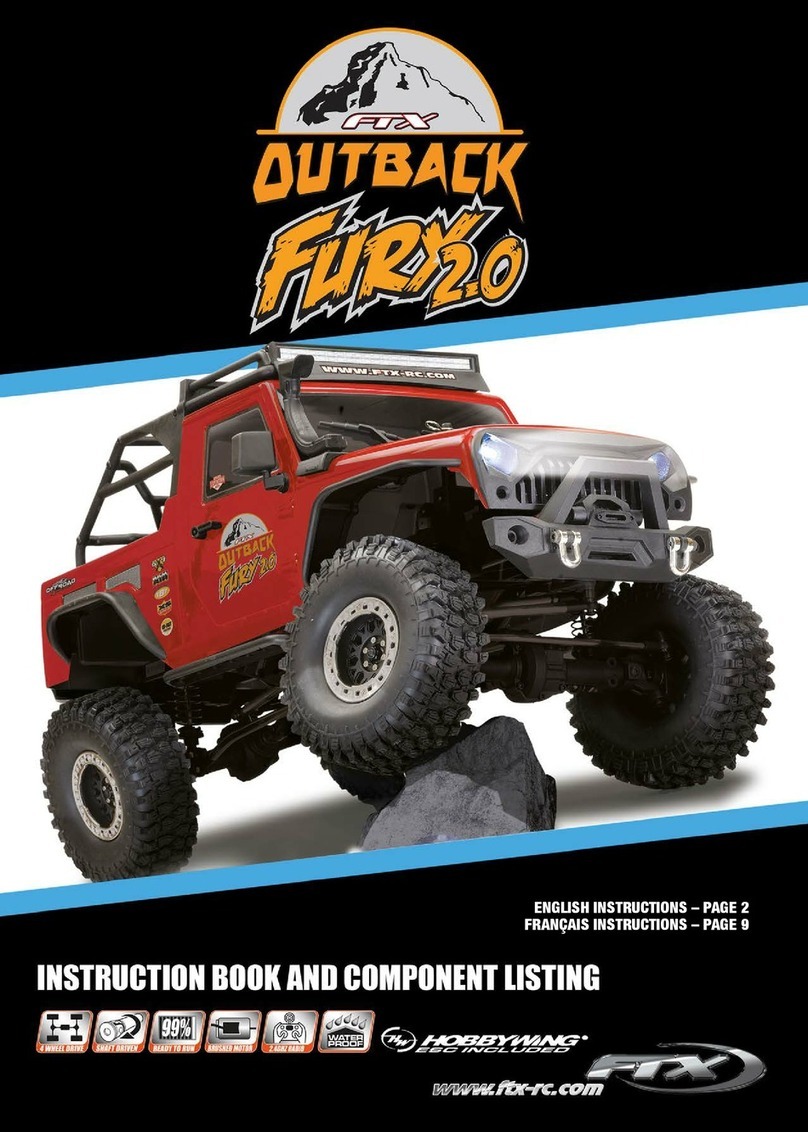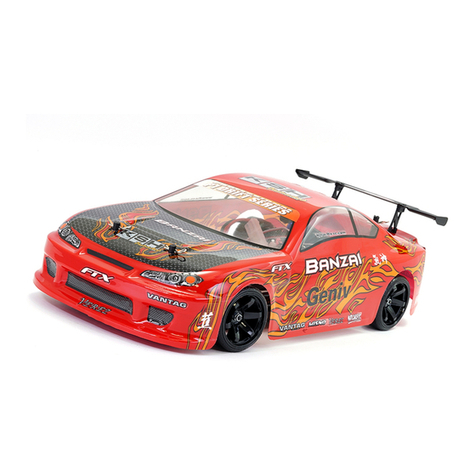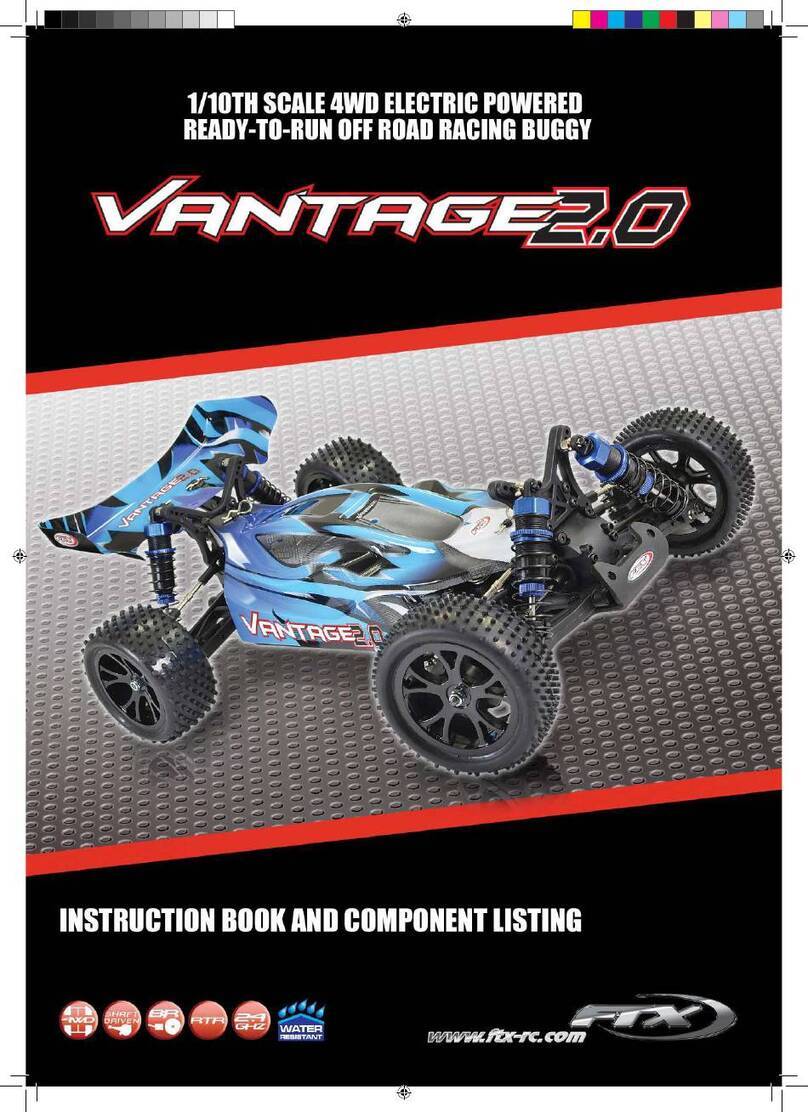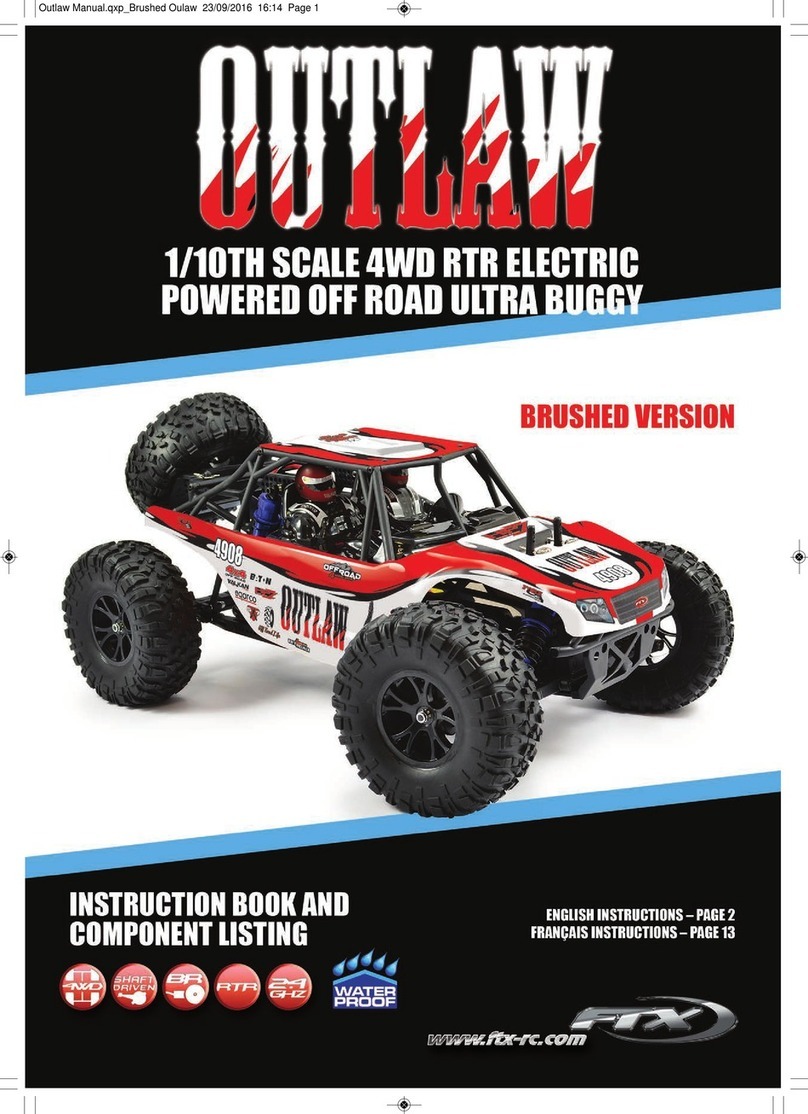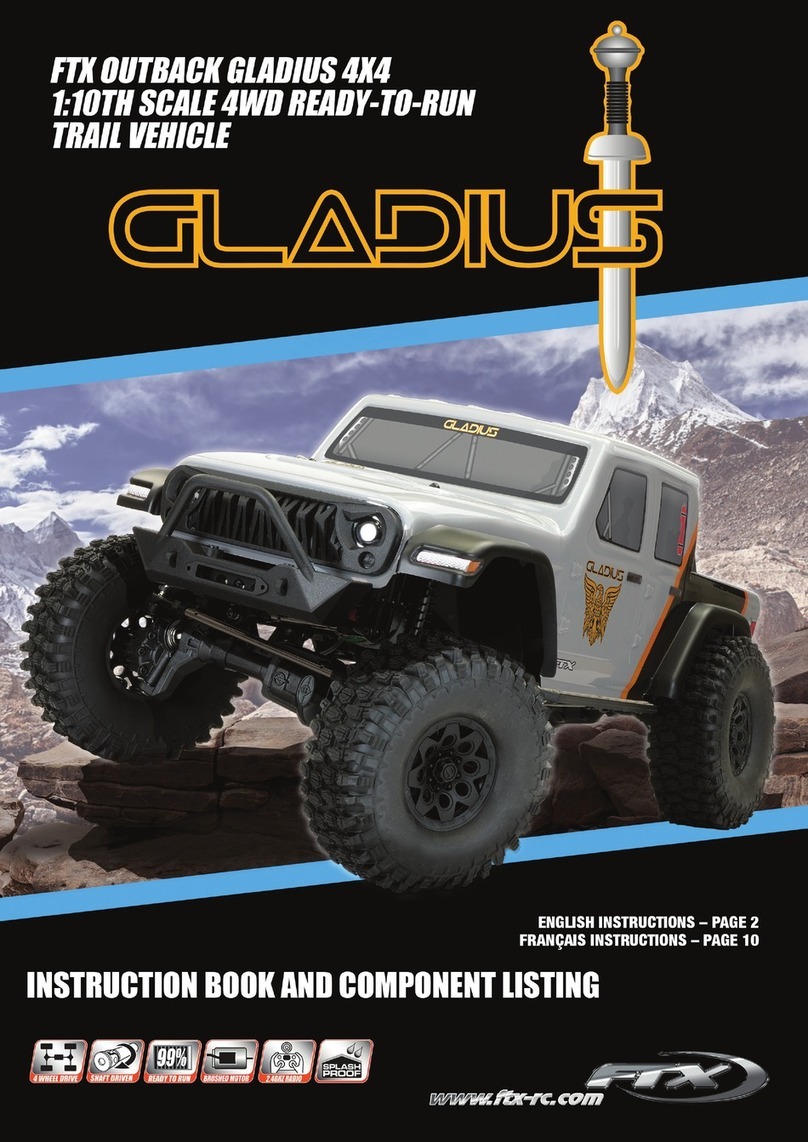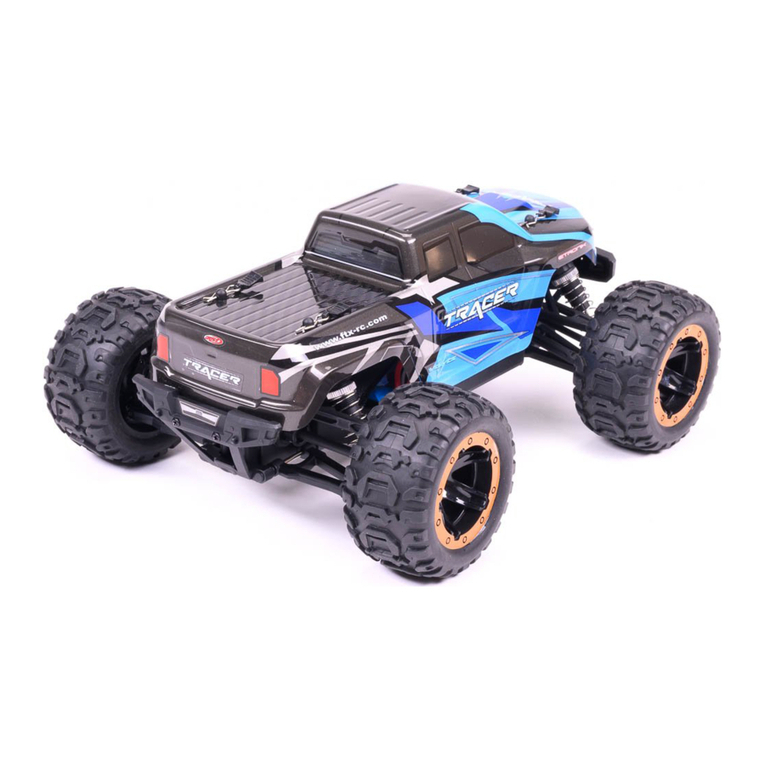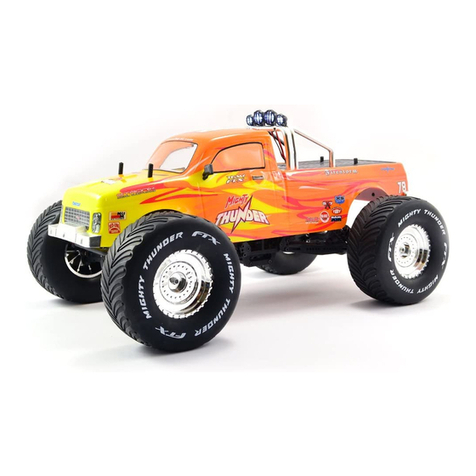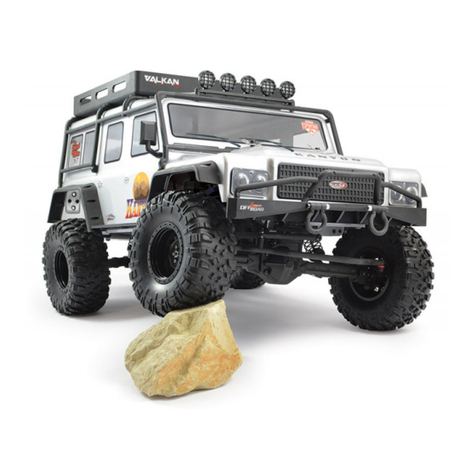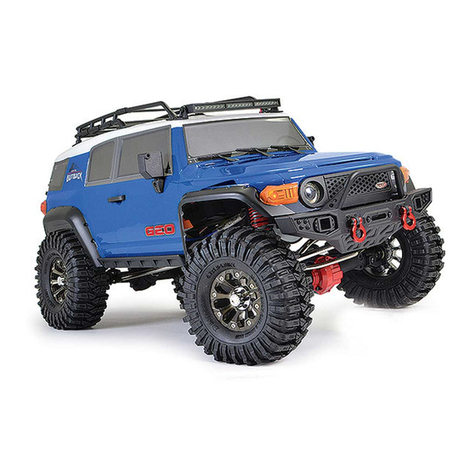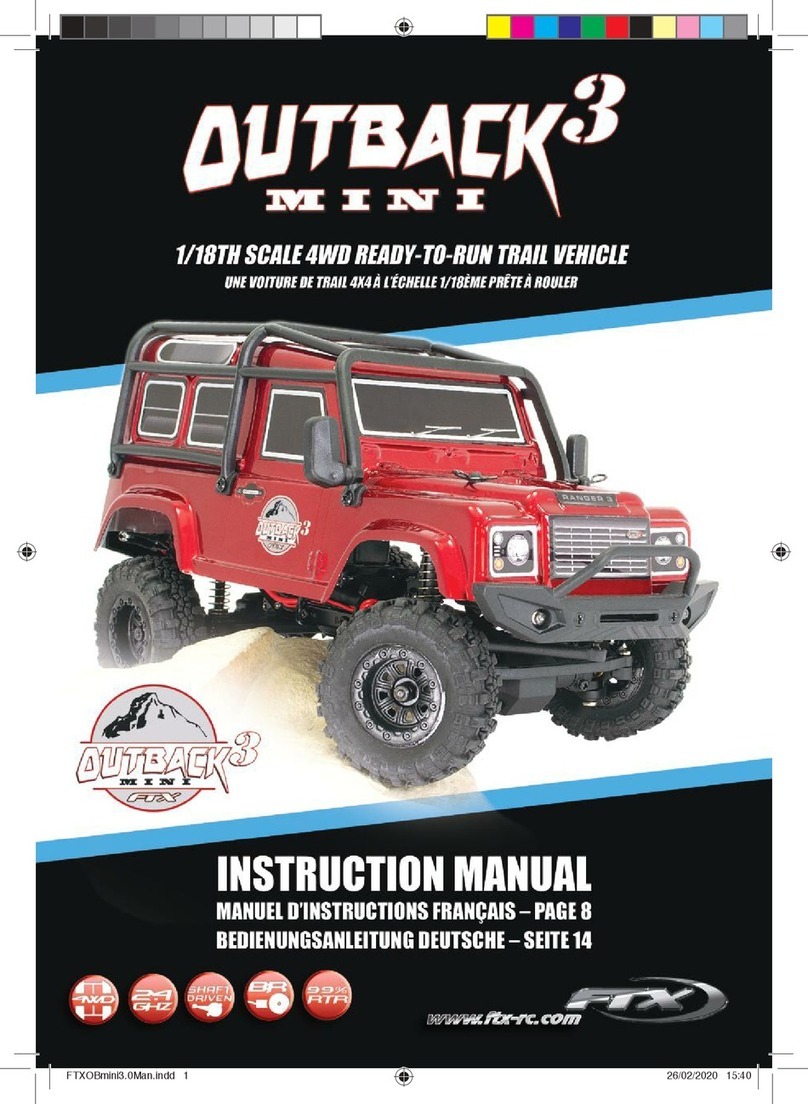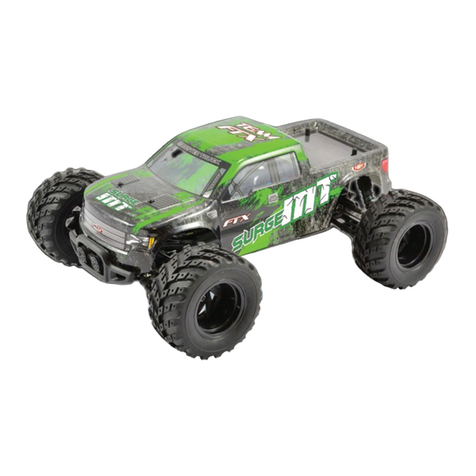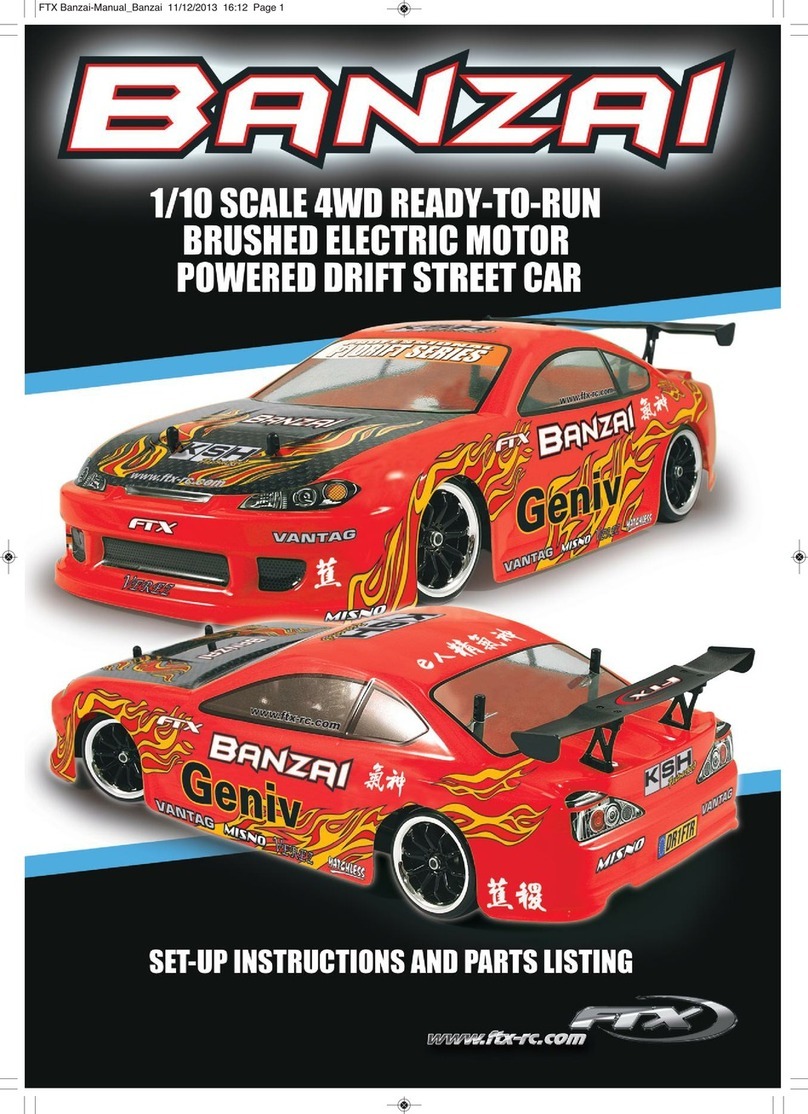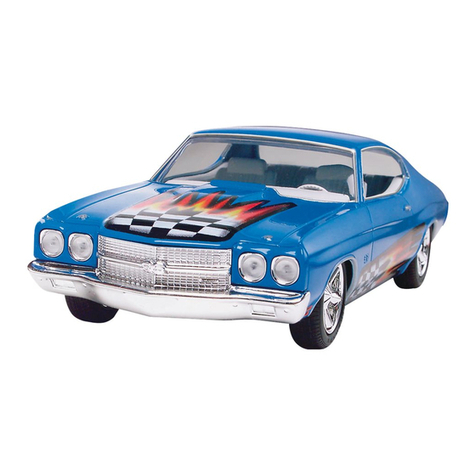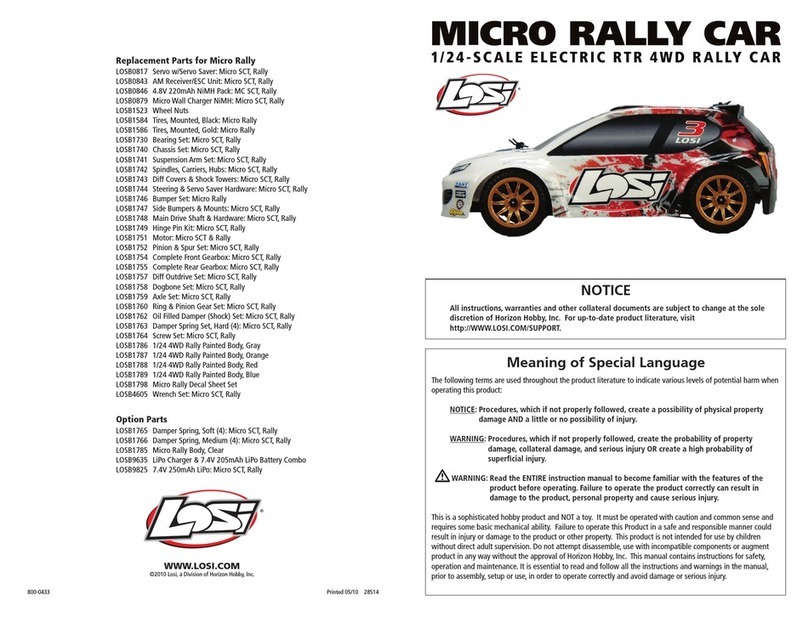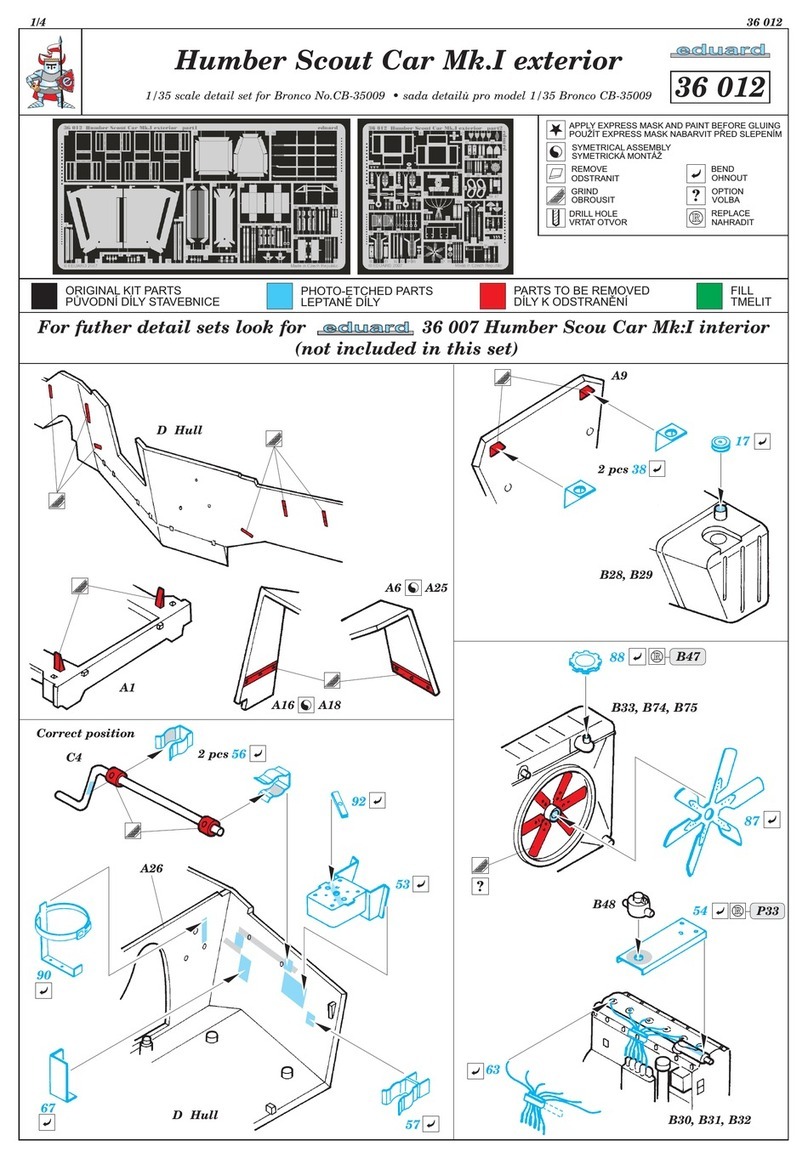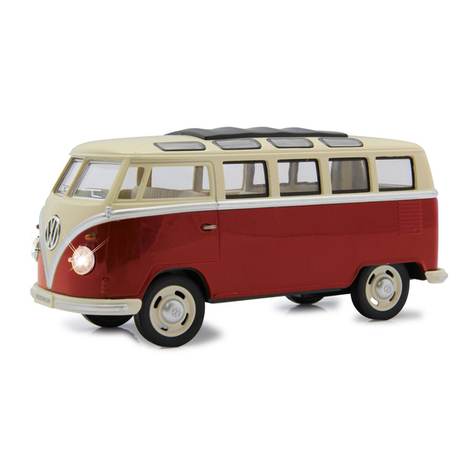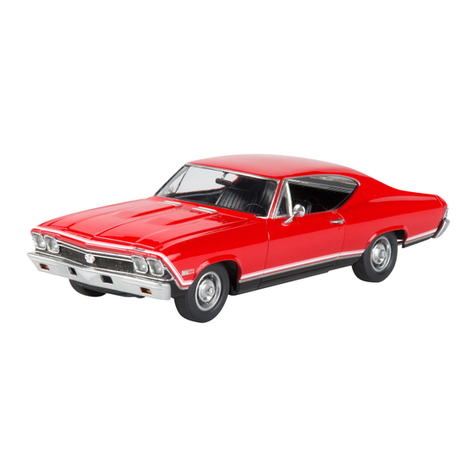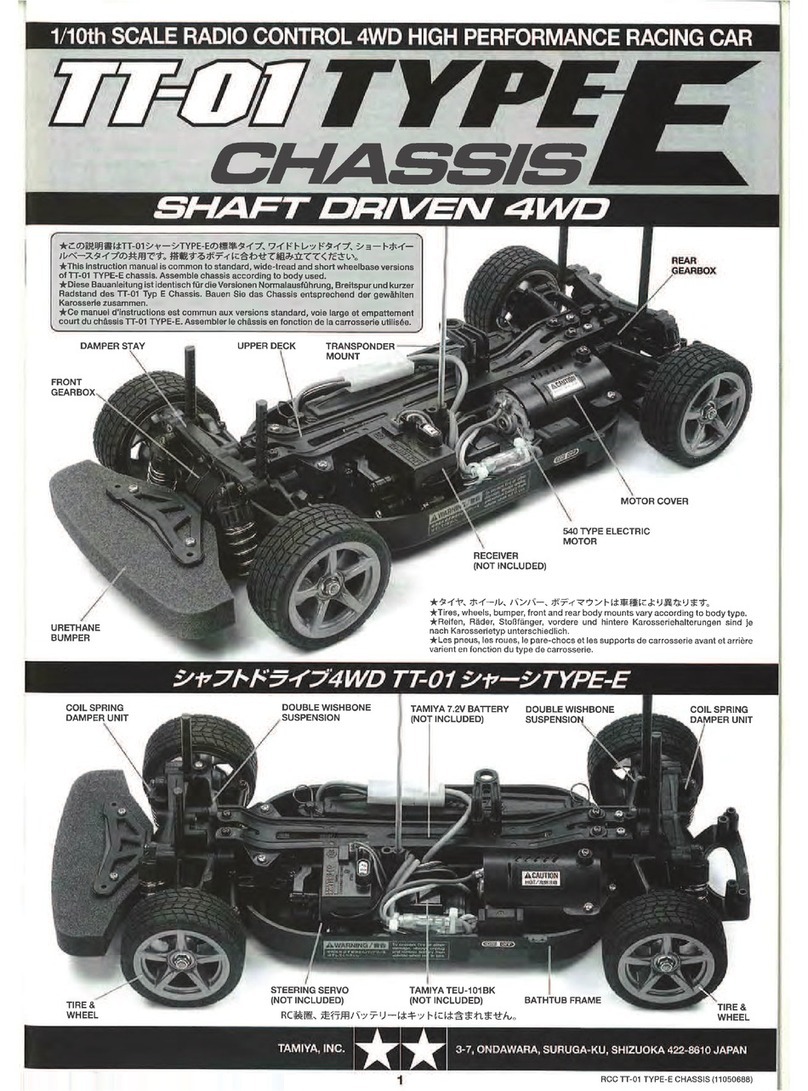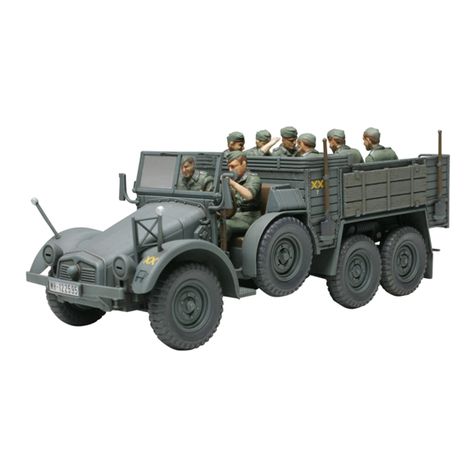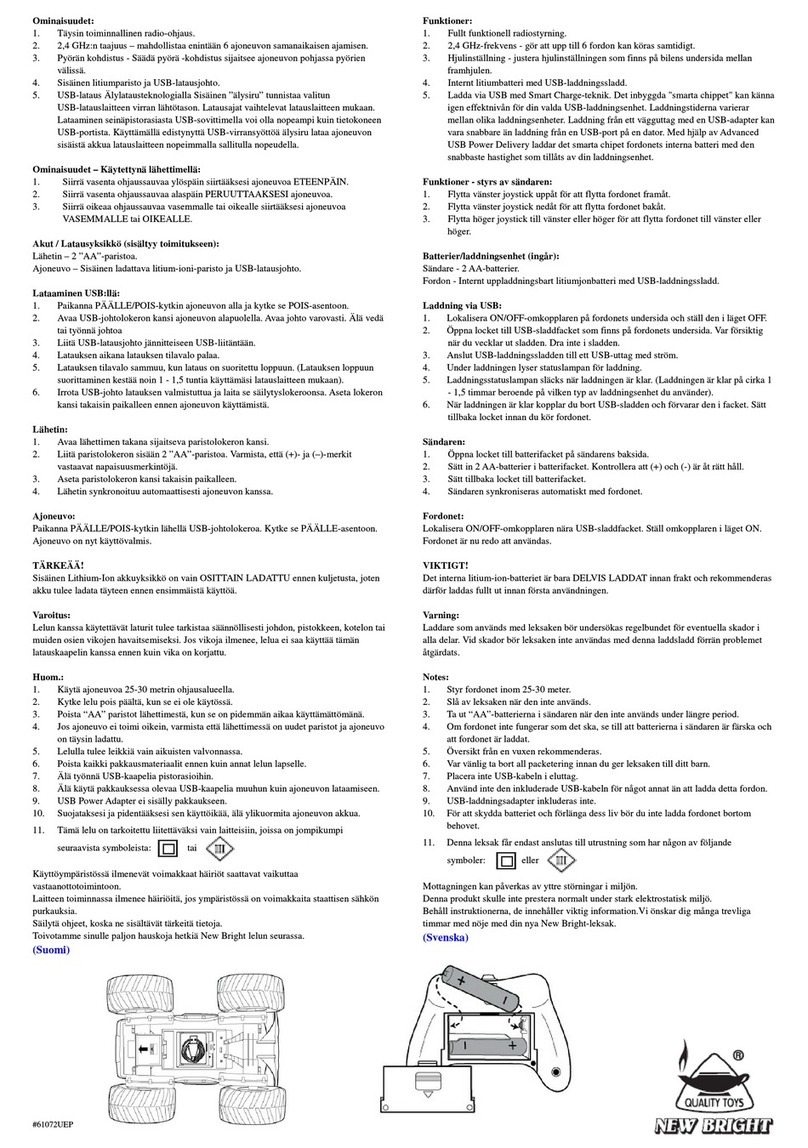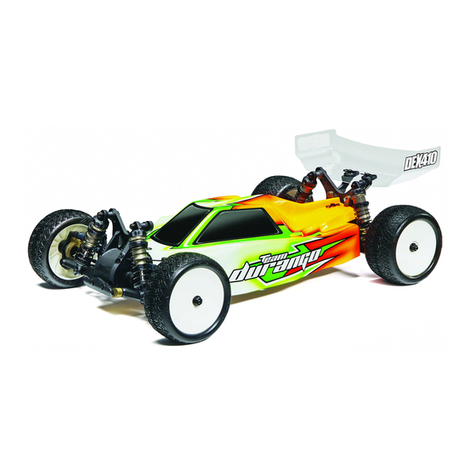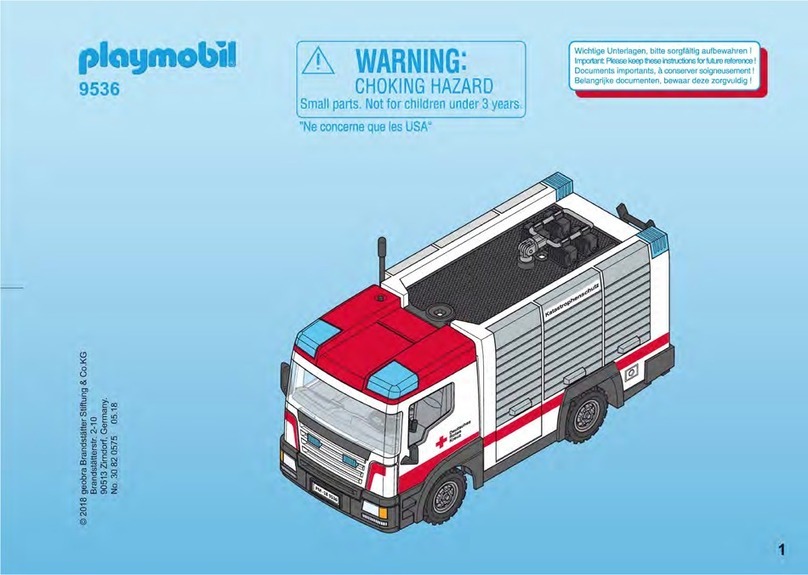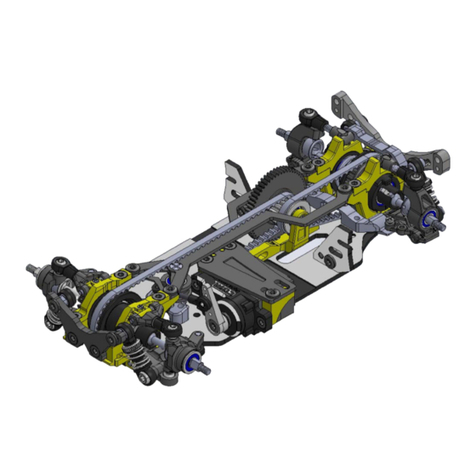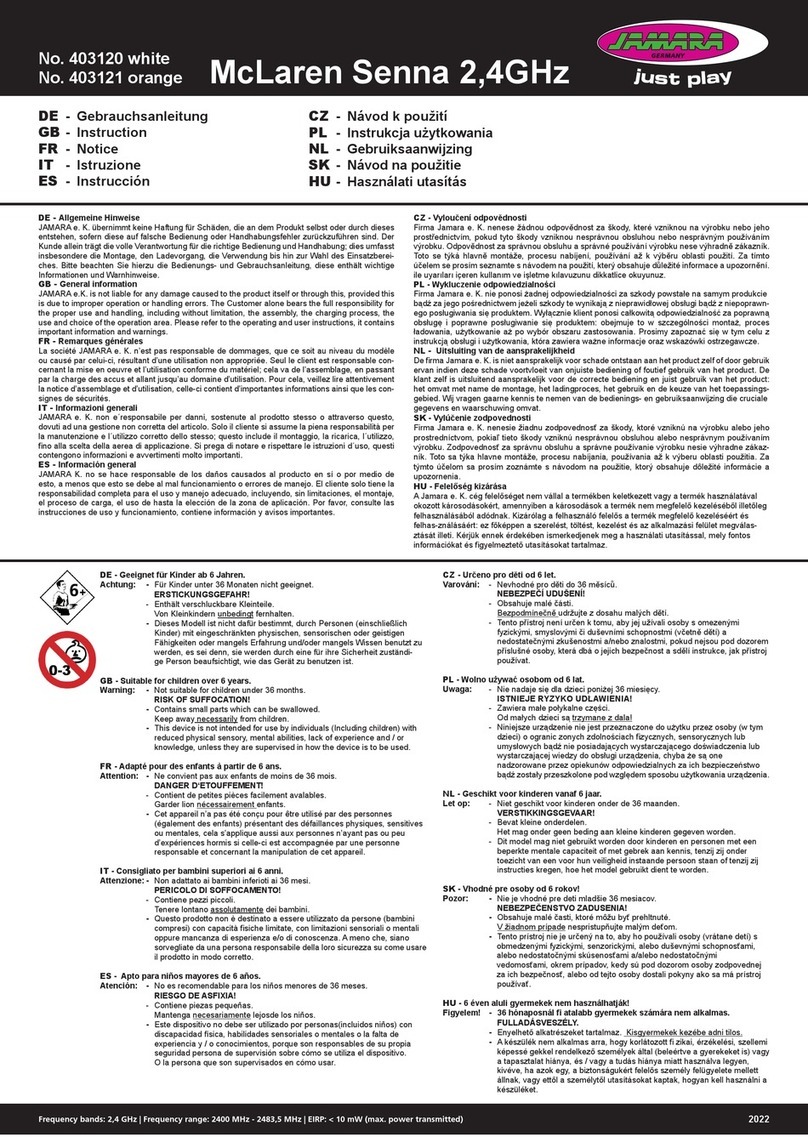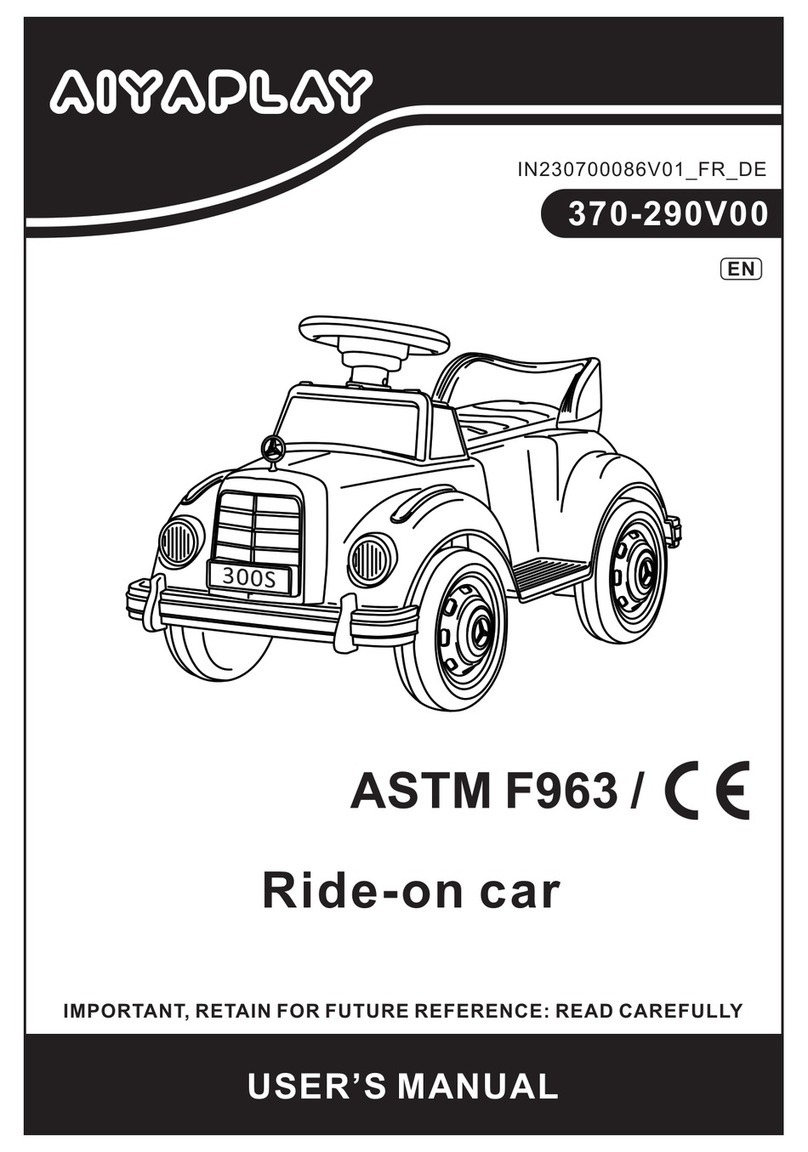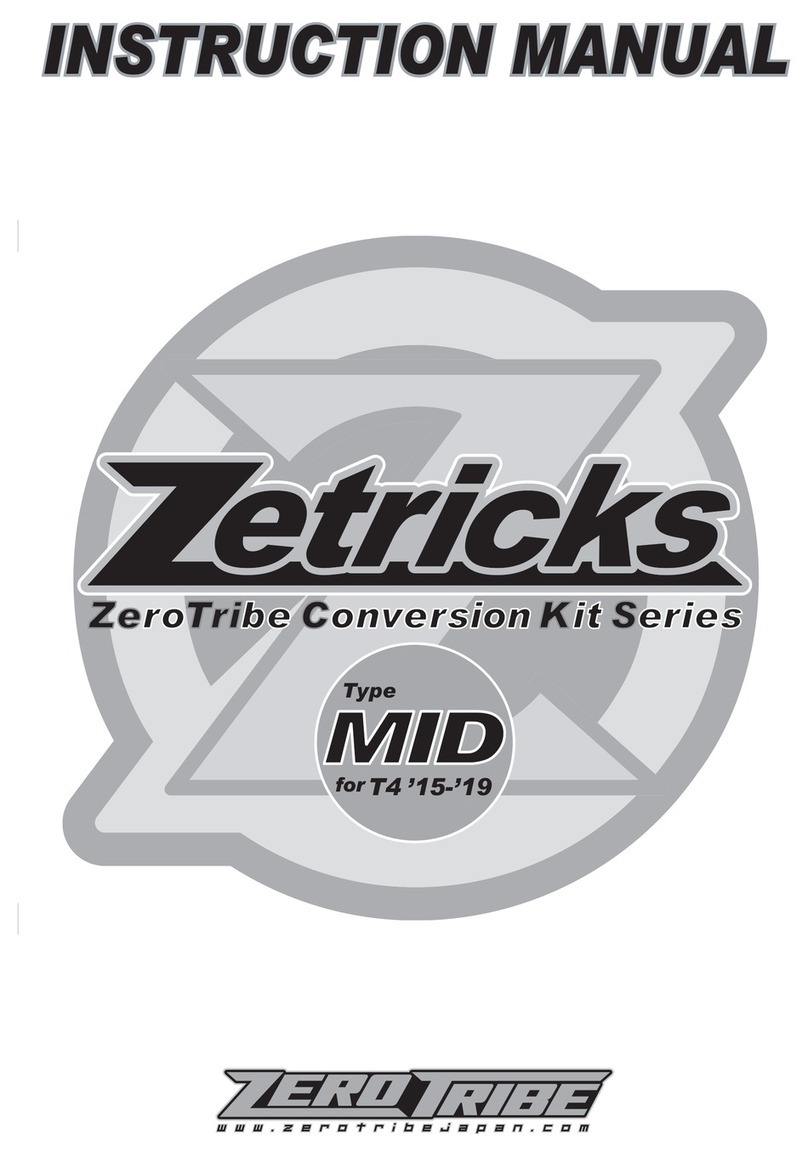
5
ESC Operation
Thanks for purchasing our electronic speed controller(ESC). The power system for RC model
can be very dangerous, please read this manual carefully. In that we have no control over
the correct use, installation, application, or maintenance of our products, no liability shall be
assumed nor accepted for any damages, losses or costs resulting from the use of the product.
FEATURES:
• Water-proof and dust-proof for all weather races.
• Small size with built-in capacitor module.
• Automatic throttle range calibration, easy to use.
• Multiple protections: Low voltage cut-off protection for Lipo or NiMH battery /
Over-heat protection / Throttle signal loss protection.
• Easily programmed with the jumpers.
SPECIFICATION
* There are 2 kinds of WP-1040-BRUSHED-Crawler& Boat speed controllers, one has 1 output
for 1 motor, and the other one has 2 outputs for 2 motors (2 motors work synchronously).
** The WP-860-DUAL BRUSHED has 2 outputs to drive 2 motors synchronously. When driving 2
motors, the Turns of the motors need to be increased.
BEGIN TO USE
1. Connect the ESC, motor, receiver, battery and servo according to the following diagram:
“+” and “-” wires of the ESC are connected to the battery pack.
Attention: The incorrect polarity will damage the ESC immediately.
The control cable of the ESC (trio wires with black, red and white color) is connected to
the throttle channel of the receiver (Usually CH2). The “Motor +” and “Motor –” wires are
connected to ESC without any order.
If the motor runs in the opposite direction, please swap these two wire connections.
2. Set the Transmitter
Please set the “D/R”, “EPA” and “ATL” to 100% for throttle channel (for transmitter without
LCD, please turn the knobs to the maximum value), and set the “TRIM” of the throttle channel
to 0 (for transmitter without LCD, please turn the TRIM knob to its neutral position).
For FutabaTM and the similar transmitters, the direction of throttle
channel shall be set to “REV”, while other radio systems shall be set to “NOR”.
The “Fail Save” function of the radio system is strongly recommended to be activated. Please
make sure that the motor can be stopped when the “Fail Save” happens.
3. Throttle Range Setting (Throttle Range Calibration)
In order to make the ESC match the throttle range of different transmitters, the calibration of
the ESC is necessary.
To calibrate the ESC, please turn on the transmitter, keep throttle stick at its neutral position,
wait for 3 seconds to let the ESC execute self-test and automatic throttle calibration. When the
ESC is ready to run, a long beep sound is emitted from the motor.
Note: Please calibrate the throttle range again when using a new transmitter or changing the
settings of the neutral position of throttle channel, D/R, ATV, ATL or EPA parameters,otherwise
the ESC may not work properly.
BEEP SOUND AND LED STATUS
SET THE ESC
The ESC is programmed by the jumpers
(Tweezers are recommended to plug and unplug the jumper).
PROTECTION FUNCTIONS
1. Low voltage Cut-off (LVC) protection: If the voltage of battery pack is lower than the
threshold for 2 seconds, the ESC will enter the protection mode.
When the car stops, the red LED blinks to indicate the low voltage cut-off protection has been
activated.
Table A: LVC protection for WP-1060-BRUSHED, WP-1040-
BRUSHED, WP-860-DUAL BRUSHED (F/B/R or F/B mode).
Model WP-1040-BRUSHED
WP-1040-BRUSHED-Crawler & Boat *
Cont. / Burst Current Forward: 40A / 180A
Backward: 20A / 90A
Input 2-3S Lipo, 5-9 Cells NiMH
Cars Applicable 1:10 on-road, off-road Buggy, Truggy, SCT
1:10 Crawler, Tank & Boat
Motor
Limit
2S Lipo or
5-6 cells NiMH
3S Lipo or
7-9 cells NiMH
540 or 550 size motor ≥12T
or RPM < 30000 @7.2V
540 or 550 size motor ≥18T
or RPM < 20000 @7.2V
Resistance Fwd: 0.002 Ohm, Bwd: 0.004 Ohm
Built-in BEC 2A/6V (Linear mode BEC)
Dimension &
Weight WP-1040-BRUSHED: 46.5*34*28.5, 65g
WP-1040-BRUSHED-CRAWLER: 46.5*34*28.5, 70g
Neutral Point Top point of forward
direction Top point of backward
direction
THROTTLE STICK POSITION
User Manual of Water-Proof Brushed Speed Controller (RTR Version) HW-SM690ENG-V3-20160603Page - 1 -
Thanks for purchasing our electronic speed controller(ESC). The power system for RC model can be very
dangerous, please read this manual carefully. In that we have no control over the correct use, installation,
application, or maintenance of our products, no liability shall be assumed nor accepted for any damages,
losses or costs resulting from the use of the product.
【【FEATURES】】
1. Water-proof and dust-prooffor all weather races.
2. Small size with built-in capacitor module.
3. Automatic throttle range calibration, easy to use.
4. Multiple protections: Low voltage cut-off protection for Lipo or NiMH battery / Over-heat protection / Throttle signal
5. Easily programmed with the jumpers.
【【SPECIFICATIONS】】
* There are 2 kinds of WP-1040-BRUSHED-Crawler& Boat speed controllers, one has 1 output for 1 motor, and the other
one has 2 outputs for 2 motors (2 motors work synchronously).
** The WP-860-DUAL BRUSHED has 2 outputs to drive 2 motors synchronously. When driving 2 motors, the Turns of the
motors need to be increased.
【【BEGIN TO USE】】
1. Connect the ESC, motor, receiver, battery and servo according to the following diagram
“+” and “-” wires of the ESC are connected to the battery pack.
Attention: The incorrect polarity will damage the ESC immediately.
The control cable of the ESC (trio
wires with black, red and white color)
is connected to the throttle channel
of the receiver (Usually CH2). The
“Motor +” and “Motor –” wires are
connected to ESC without any order.
If the motor runs in the opposite
direction, please swap these two
Please set the “D/R”, “EPA” and
“ATL” to 100% for throttle channel
(for transmitter without LCD, please
turn the knobs to the maximum
value), and set the “TRIM” of the
throttle channel to 0 (for transmitter
without LCD, please turn the TRIM
knob to its neutral position).
For FutabaTM and the similar
transmitters, the direction of throttle
channel shall be set to “REV”, while
other radio systems shall be set to “NOR”.
The “Fail Save” function of the radio system is strongly recommended to be activated. Please make sure that the motor
can be stopped when the “Fail Save” happens.
3. Throttle Range Setting (Throttle Range Calibration)
In order to make the ESC match the throttle range of different transmitters, the calibrationof the ESC is necessary.
To calibrate the ESC, please turn on the transmitter, keep throttle stick at its neutral position, wait for 3 seconds to let the
ESC execute self-test and automatic throttle calibration. When the ESC is ready to run, a long beep sound is emitted
from the motor.
Note: Please calibrate the throttle range again when using a new transmitter or changing the settings of the neutral
position of throttle channel, D/R, ATV, ATL or EPA parameters,otherwise the ESC may not work properly.
【【BEEP SOUND AND LED STATUS】】
The Meaning of Beep Sound
1 short Beep: The battery is NiMH/NiCd
2 short Beeps: The battery is 2S Lipo
3 short Beeps: The battery is 3S Lipo
4 short Beeps: The battery is 4S Lipo
1 long Beep: Self-test and throttle calibration is
OK, the ESC is ready to run
When the throttle stick is in neutral range, red LED is off
Forward, brake or reverse at partial throttle, red LED blinks
Forward, brake or reverse at full throttle, red LED is solid
【【THROTTLE STICK POSITION】】
【【SET THE ESC】】
The ESC is programmed by the jumpers
(Tweezers is recommended to plug and unplug the jumper).
WP-1040-BRUSHED
WP-1040-BRUSHED-Crawler& Boat *
Forward: 40A / 180A
Backward: 20A / 90A
Forward: 60A / 360A
Backward: 30A / 180A
2-3S Lipo, 5-9 Cells NiMH
1:10 on-road, off-road Buggy, Truggy, SCT
1:10 Crawler, Tank &Boat
540 or 550 size motor ≥12T
or RPM < 30000 @7.2V
540 or 550 size motor ≥ 8T
or RPM <45000 @7.2V
540 or 550 size motor ≥18T
or RPM < 20000 @7.2V
540 or 550 size motor ≥13T
or RPM <30000 @7.2V
Fwd: 0.002 Ohm, Bwd: 0.004 Ohm
Fwd: 0.0008 Ohm, Bwd: 0.0016 Ohm
WP-1040-BRUSHED: 46.5*34*28.5, 65g
WP-1040-BRUSHED-CRAWLER: 46.5*34*28.5, 70g
WP-1625-BRUSHED
WP-1625-BRUSHED-Crawler
Forward: 25A / 100A
Backward: 25A / 100A
Forward: 60A / 360A
Backward: 30A / 180A
2-3S Lipo, 5-9 Cells NiMH
2-4S Lipo, 10-12 Cells NiMH
1:18 & 1:16 on-road, off-road
1:18 & 1:16 Crawler and Boat
1:8 on-road, off-road, Buggy, Truggy, Monster
Crawler and Boat
280, 370 or 380 size motor
or RPM < 30000 @7.2V
540, 550 or 775 size motor ≥12T
or RPM < 30000 @7.2V
280, 370 or 380 size motor
or RPM <20000 @7.2V
540, 550 or 775 size motor ≥18T
or RPM <20000 @7.2V
540, 550 or 775 size motor ≥24T
or RPM <15000 @7.2V
Fwd: 0.003 Ohm, Bwd: 0.003 Ohm
Fwd: 0.001 Ohm, Bwd: 0.002 Ohm
SPEED CONTROL CONNECTION DIAGRAM
The Meaning of Beep Sound
• 1 short Beep: The battery is NiMH/NiCd
• 2 short Beeps: The battery is 2S Lipo
• 3 short Beeps: The battery is 3S Lipo
• 4 short Beeps: The battery is 4S Lipo
• 1 long Beep: Self-test and throttle calibration is OK, the ESC is ready to run
LED Status
• When the throttle stick is in neutral range, red LED is off
• Forward, brake or reverse at partial throttle, red LED blinks
• Forward, brake or reverse at full throttle, red LED is solid
User Manual of Water-Proof Brushed Speed Controller (RTR Version) HW-SM690ENG-V3-20160603Page - 2 -
【PROTECTION FUNCTIONS】
1. Low voltage Cut-off (LVC) protection: If the voltage of battery pack is lower than the threshold for 2 seconds, the
ESC will enter the protection mode.
When the car stops, the red LED blinks to indicate the low voltage cut-off protection has been activated.
Table A: LVC protection for WP-1060-BRUSHED, WP-1040-BRUSHED, WP-860-DUAL BRUSHED (F/B/R or F/B
mode).
Output reduces 50% at 6.5V
Output cuts off at 6.0V,
cannot be recovered
Output reduces 50% at 9.75V
Output cuts off at 9.0V, cannot
be recovered
Output reduces 50% at 13V
Output cuts off at 12V, cannot
be recovered
Output reduces 50% at 4.5V
Output cuts off at 4.0V, cannot
be recovered
Table B: LVC protection for WP-1625-BRUSHED-Crawler, WP-1040-BRUSHED-Crawler&Boat, WP-860-DUAL
BRUSHED (Crawler or Boat mode).
Output cuts off at 6.5V.
If the throttle stick moves to
neutral and then up again, the
output can be recovered to
50%.
If the voltage drops to 6.5V
again, the above process
repeats in circles.
Output cuts off at 9.75V.
If the throttle stick moves to
neutral and then up again, the
output can be recovered to
50%.
If the voltage drops to 9.75V
again, the above process
repeats in circles.
Output cuts off at 13V.
If the throttle stick moves to
neutral and then up again, the
output can be recovered to
50%.
If the voltage drops to 13V
again, the above process
repeats in circles
Output cuts off at 4.5V.
If the throttle stick moves to
neutral and then up again, the
output can be recovered to
50%.
If the voltage drops to 4.5V
again, the above process
repeats in circles.
2. Over-heat protection: When the internal temperature of the ESC is higher than 100 Celsius degree or 212
Fahrenheit degree for 5 seconds, the ESC will reduce and cut off the output power.
When the car stops, the red LED blinks to indicate the over-heat protection has been activated. If the ESC cools
down to 80 Celsius degree (176 Fahrenheit degree) the output power is recovered to normal state.
3. Throttle signal loss protection: The ESC will cut off the output power if the throttle signal has been lost for 0.1 second.
The “Fail Save” function of the radio system is strongly recommended to be activated.
【THE DIFFERENCE BETWEEN “BRUSHED” AND “BRUSHED-CRAWLER& BOAT” ESC】
1. “Brushed” and “Brushed-Crawler& Boat” ESCs have different backward-running modes.
“Brushed” ESC uses “Double-Click” method to make the car go backward. When you move the throttle stick from
forward zone to backward zone for the first time, the ESC begins to brake the motor, the motor speeds down but
still running, so the backward action is NOT happened at this moment. When the throttle stick is moved to the
backward zone again (The 2nd “click”), if the motor speed is slowed down to zero (i.e. stopped), the backward
action will be activated. The “Double-Click” method prevents mistakenly reverse when the brake function is
frequently used in steering.
“Brushed-Crawler& Boat” ESC uses “Single-click” to make the car go backward. When you move the throttle stick
from forward zone to backward zone, the car will go backward immediately. This mode is common for the Rock
Crawler and tank.
2. The maximum reverse force (for backward running) is 50% for the general “Brushed” ESC, 100% for the “Crawler”
mode of a “Brushed-Crawler & Boat” ESC, and 25% for the "Boat" mode of a “Brushed-Crawler & Boat” ESC.
3. The Low Voltage Cut-off Protection modes are different (Please check the instructions in the section of
“PROTECTION FUNCTIONS”).
【TROUBLE SHOOTING】
After power on, motor can’t work, no
sound is emitted, and LED is off.
The ESC doesn’t get its working
voltage; Connections between
battery pack and ESC are
Check the battery wires connection
or replace the defective connectors.
After power on, motor can’t work; red
Throttle signal is abnormal.
Check the throttle wire connection;
make sure it is plugged into the
throttle channel of the receiver.
Set the “TRIM” of throttle channel to
0 or turn the knob to its neutral
The car runs backward while giving
throttle.
(The motor runs in the opposite
The wire connections between
ESC and the motor need to be
changed.
Swap two wire connections between
The car can’t go backward.
The jumper position is wrong.
Check the jumper and plug it to the
correct position.
The neutral point of throttle
channel is changed or drifted.
Set the “TRIM” of throttle channel to
0 or turn the knob to its neutral
The car can’t go forward, but can go
The direction of throttle channel
Reset the direction of throttle
channel from original “NOR” to
“REV”, or from original “REV” to
The motor doesn’t work, but the LED in
The connections between motor
and ESC are broken.
Check the connections and replace
the defective connectors.
The motor suddenly stops running
The throttle signal is lost.
Check the transmitter and the
Check the throttle wire connection.
Low voltage cut-offprotection
or Over-heat cut-off protection
Replace the battery pack, or cool
The car cannot get top speed and the
red LED doesn’t solid on at full throttle
Some setting in the transmitter
Set D/R, EPA, ATL to 100% or turn
the knobs to maximum value.
Set TRIM to 0 or turn the knob to its
Motor is cogging when accelerated
The battery has limited
discharge ability.
Use battery with better discharge
ability.
Motor RPM is too high, the gear
Use motor with lower RPM, or use
smaller pinion to get softer gear
Something wrong in the driving
system of the car.
Check the driving system of the car.
Output reduces 50%
at 6.5V Output cuts
off at 6.0V, cannot be
recovered
Output reduces 50%
at 9.75V Output cuts
off at 9.0V, cannot be
recovered
Output reduces 50%
at 13V Output cuts
off at 12V, cannot be
recovered
Output reduces 50%
at 4.5V Output cuts
off at 4.0V, cannot be
recovered
2S Lipo 3S Lipo 4S Lipo 5-9 cells NiMH
FTX Outback Hi-Rock Manual.indd 5FTX Outback Hi-Rock Manual.indd 5 18/12/2019 14:5418/12/2019 14:54


